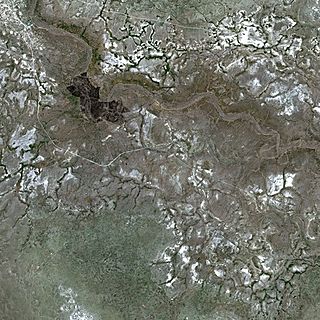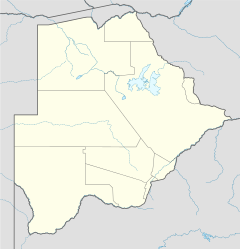
Botswana is a landlocked country located in Southern Africa, north of South Africa. Botswana occupies an area of 581,730 square kilometres (224,610 sq mi), of which 566,730 km2 (218,820 sq mi) are land. Botswana has land boundaries of combined length 4,347.15 kilometres (2,701.19 mi), of which the constituent boundaries are shared with Namibia, for 1,544 km (959 mi); South Africa 1,969 km (1,223 mi); Zimbabwe, 834 km (518 mi) and Zambia, 0.15 km (0.093 mi). Much of the population of Botswana is concentrated in the eastern part of the country.

Dibble is a town in McClain County, Oklahoma, United States. The population within city limits was 878 at the 2010 census. The community has 8,868 residents in its 73031 zipcode, according to Sperling's Best Places. Dibble is in the outer suburban area west of Purcell and southwest of Norman, in the Oklahoma City Metropolitan Area, according to the U.S. Census.

Lake Makgadikgadi ( məˈkɑːdiˈkɑːdi) was a paleolake that existed in what is now the Kalahari Desert in Botswana from 2,000,000 years BP to 10,000 years BP. It may have once covered an area of from 80,000 to 275,000 km2 and was 30 m deep. The Okavango, Upper Zambezi, and Cuando rivers once all emptied into the lake. Its remains are seen in the Makgadikgadi salt pans, one of the largest salt pans in the world.

Maun is the fifth-largest town in Botswana. As of 2011, it had a population of 55,784. Maun is the "tourism capital" of Botswana and the administrative centre of Ngamiland district. Francistown and Maun are linked by the A3 highway. It is also the headquarters of numerous safari and air-charter operations who run trips into the Okavango Delta.

The North-East District is one of the administrative districts of Botswana. Its capital is Francistown. In 2011, North-East had a population of 60,264 people. The district is predominantly occupied by Kalanga-speaking people, the BaKalanga. The district is administered by a district administration and district council, which are responsible for local administration.

The Makgadikgadi Pan, a salt pan situated in the middle of the dry savanna of north-eastern Botswana, is one of the largest salt flats in the world. The pan is all that remains of the formerly enormous Lake Makgadikgadi, which once covered an area larger than Switzerland, but dried up tens of thousands of years ago. Recent studies of human mitochondrial DNA suggest that modern Homo sapiens first began to evolve in this region some 200,000 years ago, when it was a vast, exceptionally fertile area of lakes, rivers, marshes, woodlands and grasslands especially favorable for habitation by evolving hominins and other mammals.

Nata is a village in Central District of Botswana. It is located in the northern part of the district, and is served by Nata Airport. The population was 6,802 at the 2011 census. The village of Nata lies along the Nata River, which carries its rainy season flow to the Makgadikgadi Pans, a seasonal hypersaline lake.

Mosu is a village in Central District of Botswana. The village is located to the south of Sua Pan – the eastern half of Makgadikgadi Pan – and it has a primary school and a junior secondary school namely Mosu Primary School and Makgadikgadi Junior Secondary School respectively. The population was 1,792 in 2011 census. Mosu is also the gateway to Makgadikgadi plains. Village is located on the foot of a hilly landform, exposing the village's terrain to massive soil erosion.

Mmatshumo is a village in Central District (Botswana) of Botswana. It is located close to Makgadikgadi salt Pan. An area of wide open uninhabited spaces with endless horizons i.e. the remains of what used to be the largest ancient mainland superlake. The village has administrative offices i.e. kgotla currently headed by kgosi Phetsogang, primary school, postoffice, bars, shops and a health clinic. In the north of Mmatshumo village lies Khubu Island aka Gaio and in the south of this village lies Damtshaa diamond mine operated by Debswana Company. The road linking Letlhakane in the south to Mmatshumo is tarred. Due to the diamond mining activities in the vicinity of this village, it is expected to see population and business boom in the coming years. According to 2011 Botswana Population and Housing Census, Mmatshumo and associated localities had a total population of 1 650. The contribution from Mmatshumo village alone was 1 122 with 524 males and 598 females.

Toromoja is a village in Central District of Botswana. The village is located close to Makgadikgadi Pan, in the western part of the district, and it has a primary school. The population was 649 in 2001 census.

Mokobaxane is a village in Central District of Botswana. The village is located a few kilometres from a larger village of Mopipi close to Makgadikgadi Pan, and it has a primary school. The population was 1,290 in 2001 census.

Mopipi is a village in Central District of Botswana. It is located close to Makgadikgadi Pan.It lies at the latitude 21.2001° S, 24.8656° E. The population was 3,066 in 2001 census.This village was named after a tree called Mopipi,which is commonly found in the region.. This area has witnessed steady acidification and desertification since the Pleistocene, but perhaps most dramatically since the 19th century. In particular, the Boteti River used to flow year around in this area on its way to discharge to the Makgadikgadi Pans, but presently this flow is only in the rainy season.
The Semowane River is a major natural watercourse in Southern Africa. Within Botswana the Semowane River forms a boundary between several governmental jurisdictions. This river is a vital source of water to the ephemeral wetlands of the Makgadikgadi, where a number of species of limited distribution thrive. Specifically the Semowane River discharges to Sua Pan.

The Sua Pan or Sowa Pan is a large natural topographic depression within the Makgadikgadi region of Botswana. It is located near the village of Sowa, whose name means salt in the language of the San. The Sua salt pan is one of three large pans within the Makgadikgadi, the other two being Nxai Pan and Nwetwe Pan.
The Nata River or Manzamnyama River is a natural watercourse in Southern Africa. It is an ephemeral river flowing in Zimbabwe and Botswana. It has a length of 330 km from its source to mouth, 210 km in Zimbabwe and 120 km in Botswana. Its total catchment area is 24,585 km2. The river originates in Sandown, a small farming town located on the Zimbabwean central watershed 50 km south west of Bulawayo and ends in the Makgadikgadi Pans in Botswana. There is no outlet from the salt pans which can be considered as the “dead sea” of the south. The upper reaches of the river are located in a commercial farming area where good environmental and farming practices have resulted in the river experiencing very little siltation/sedimentation. Impressive sedimentation starts occurring about 65 km along the river course marking the beginning of a 90 km stretch in Zimbabwe where the river passes through communal farming areas. It is on this stretch where the sand-abstraction potential of the river is realised and communities rely on the sand river water for domestic, farming and livestock purposes. Within the country of Botswana the Nata River is a source of water to the ephemeral wetlands of the Makgadikgadi Pans, where a number of species of limited distribution thrive. Specifically the Nata River discharges to Sua Pan, draining parts of eastern Botswana and southwestern Zimbabwe.

Nxai Pan is a large salt pan topographic depression which is part of the larger Makgadikgadi Pans in northeastern Botswana. It lies on the old Pandamatenga Trail, which until the 1960s was used for overland cattle drives. The area is speckled with umbrella acacias and is said to resemble the Serengeti in Tanzania. The Nxai Pan was added to the National Park System to augment the Makgadikgadi Pans National Park, thus providing an enlarged contiguous area of natural protection.
The Mosetse River is a natural watercourse in Botswana. Within the country of Botswana the Mosetse is a source of water to the ephemeral wetlands of the Makgadikgadi Pans, where a number of crustacean species of limited distribution thrive. More specifically the Mosetse River discharges to Sua Pan, draining parts of eastern Botswana.
The Lepashe River is a natural watercourse in Botswana. It shares its name with the village of Lepashe, through which the river flows. The Lepashe River discharges to the Sua Pan. There are significant gravel resources along some reaches of the Lepashe River.

The Nata Bird Sanctuary, the only protected reserve in Botswana in the northeastern periphery of Sowa Pan, is a community-managed project, with assistance from the Nata Conservation Committee and national and international organizations. Founded in 1988, it opened for operations in 1993; it encompasses an area of 230 square kilometres (89 sq mi), with the objective of conservation of wildlife. The community project is managed by a Trust titled the "Kalahari Conservation Society", which has members drawn from the four villages of Nata, Sepako, Maposa and Manxotae in the vicinity of the sanctuary.

Winterport is a census-designated place (CDP) in the town of Winterport in Waldo County, Maine, United States. The population was 1,307 at the 2000 census.









